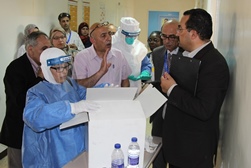 Between April and May 2015, 235 staff from ministries of health and WHO country offices in the Region were trained in various capacities under the implementation of 90-day Ebola virus disease preparedness plan developed by the WHO Regional Office31 July 2015 - The 90-day action plan for enhancing preparedness and readiness measures for Ebola virus disease (EVD) in the Eastern Mediterranean Region comes to an end through successfully hosting a series of important capacity-building activities aimed at preventing, detecting and responding to the threats of EBD.
Between April and May 2015, 235 staff from ministries of health and WHO country offices in the Region were trained in various capacities under the implementation of 90-day Ebola virus disease preparedness plan developed by the WHO Regional Office31 July 2015 - The 90-day action plan for enhancing preparedness and readiness measures for Ebola virus disease (EVD) in the Eastern Mediterranean Region comes to an end through successfully hosting a series of important capacity-building activities aimed at preventing, detecting and responding to the threats of EBD.
Activities conducted successfully during the 90-day period were in the areas of leadership and coordination, points of entry, surveillance and response, laboratory diagnosis, infection control and risk communication. The plan was formulated following a rapid assessment of preparedness and readiness measures for EVD, which was conducted by the WHO Regional Office for the Eastern Mediterranean in 20 countries in the Region between November 2014 and February 2015 involving over 100 staff and consultants. The assessment identified a number of critical gaps in the areas of prevention, early detection and response to EVD outbreak. The 90-day action plan was intended to bridge these critical gaps through activities aimed at mitigating the threats through better preparedness and readiness.
In January 2015, the third regional stakeholders’ meeting to review implementation of the International Health Regulations (IHR) with a special focus on EVD recommended to conduct activities to address strengthening of countries’ capacities. Major gaps identified during the assessment missions were the lack/limited capacities in the following areas: leadership and coordination, surveillance and response, infection prevention and control, risk communication, points of entry, and laboratory diagnosis.
One of the gaps identified was the multidisciplinary rapid response team (RRT) for surveillance and response to disease outbreaks. The pilot test for a national response team with focus on Ebola was conducted in 15–19 March 2015 in Khartoum, Sudan. The materials were then revised based on the input from the pilot training. After the pilot test in Khartoum, three other response teams reflected these changes in the module. Training for rapid response was conducted in Dubai, United Arab Emirates, from 10–15 May, in Rabat, Morocco, on 18-22 May; and in Amman, Jordan, on 24–28 May 2015.
Under surveillance and response, the implementation of events-based surveillance in the Region was initiated by preparing events-based surveillance training modules and the initiation of surveillance implementation in Qatar.
Risk communication was another major gap identified during the assessments. The following issues raised during the assessments were the following: lack of professional risk communication personnel, lack of basic media skills among health authorities at every level, lack of system for designating spokespersons, limited technical knowledge on how to communicate risk and uncertainty, poor sharing of lessons learned across region or during other events, leadership does not place value on risk communication, and the lack of training materials for stakeholders at every level. To address this issues, countries were requested to identify focal persons who will be overseeing risk communication work. Taking into consideration that risk communication is a relatively new intervention in many countries, a workshop for risk communication and social mobilization focal persons was conducted in Amman, Jordan, on 14–15 April 2015, resulting in the establishment of the Eastern Mediterranean Region Risk Communication Network. This was followed by three subregional training courses on risk communication and social mobilization for ministry of health staff, conducted in Khartoum, Sudan on 26–28 April 2015; in Muscat, Oman, on 3-5 May 2015; and in Amman, Jordan on 10–12 May.
The plan also focused on leadership and coordination that led to the development of a generic plan with 116 sets of SOPs and finalized based on a country exercise in Sudan on Ebola Preparedness and Response defining the incident command and control system with a set of procedures for the implementation for the countries to adapt.
To help strengthen national preparedness and response capacity at points of entry of countries in the Region, points of entry officials were trained on developing contingency plans for EVD with around 100 officials trained in four workshops organized in Tunisia, Jordan, Oman and Pakistan.
Moreover, capacity-building activities for essential infection prevention and control measures was conducted for 35 staff trained at the WHO collaborating centre for infection prevention and control in Riyadh, Saudi Arabia, in May 2015.
Improving biosafety measures through safe collection and transportation of dangerous pathogens and capacity building for diagnosis of EVD in laboratory was one of the major components of the plan. Under this, 21 staff were trained and certified in two rounds of training courses in May on safe collection and shipment of dangerous pathogens. In addition, 10 laboratory staff from countries were also trained in EVD diagnosis at Pasteur Institute in France.


